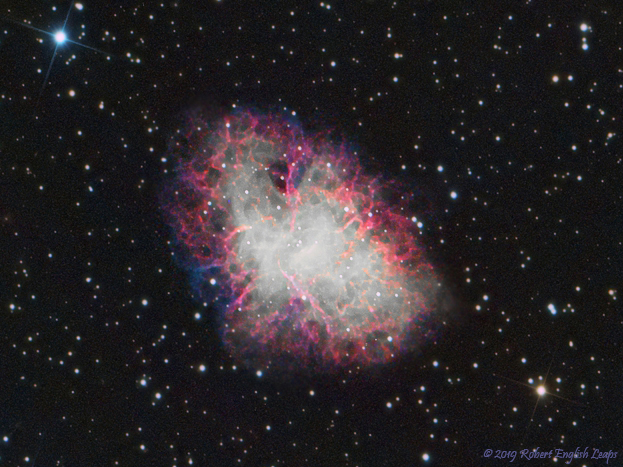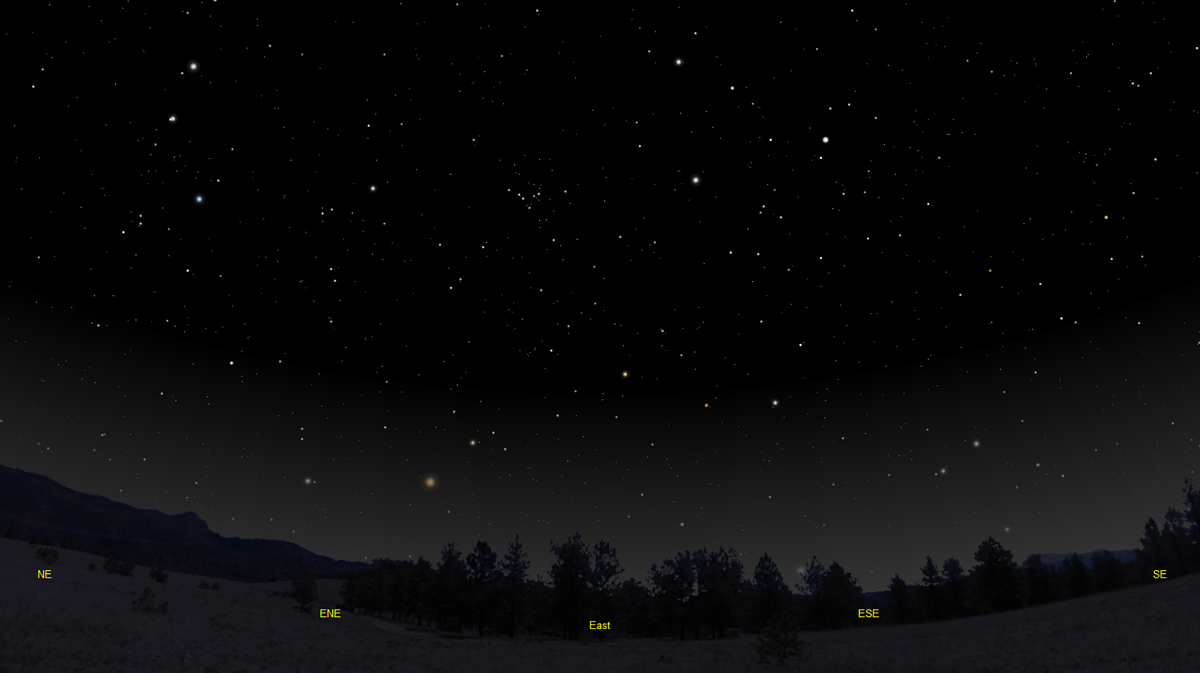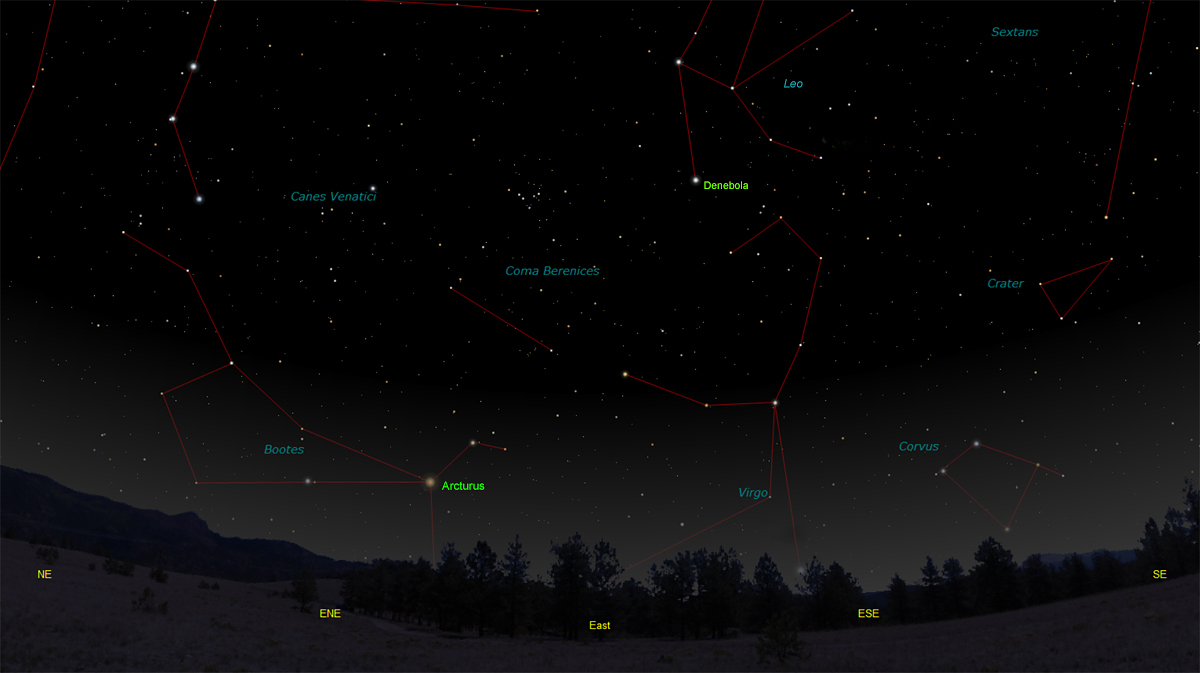The purpose of this feature is to give scout leaders, educators and naturalists an idea of some of the natural events coming up each month. We will try to cover a variety of natural events ranging from sky events to calling periods of amphibians, bird and mammal watching tips, prominent wildflowers and anything else that comes to mind. We will also note prominent constellations appearing over the eastern horizon at mid-evening each month for our area for those who would like to learn the constellations. If you have suggestions for other types of natural information you would like to see added to this calendar, let us know! Note: You can click on the hyperlinks to learn more about some of the featured items. To return to the Calendar, hit the "back" button on your browser, NOT the "back" button on the web page. All charts are available in a "printer friendly" mode, with black stars on a white background. Left clicking on each chart will take you to a printable black and white image. Though we link book references to nationwide sources, we encourage you to support your local book store whenever possible.
Notes From February 2020 It's been an interesting February. To usher in the month I had a River Otter on the lower pond! It did not see me as I crested the hill above the pond, and I got great leisurely views through binoculars. It swam several large arcs across the pond, diving beneath the surface every now and then. As it dove its thick pointed tail rose above the water's surface. On February 8th I had about four inches of snow. It fell thick and fast during the morning hours. The video below looks across the pond beside my house.
It didn't last long. By afternoon the temperatures had warmed enough that almost all of the snow was gone. At sunset a full moon rose over the lower pond. Upland Chorus Frogs called from wet areas in the fields.
The rapid weather change set the stage for the rest of the month. High winds and storms made it difficult for some of the Tennessee Amphibian Monitoring Program volunteers to run their listening routes. Some days were unseasonably warm. Officially, spring does not begin until the third week in March. But a February walk in the woods reveals signs of the upcoming season everywhere. Harbinger-of-Spring, Cut-leaved Toothwort and Spring Beauties poke through the fallen leaves. Boott's Sedge, Carex picta, blooms on the dry wooded hillsides. Upland Chorus Frogs, Spring Peepers, Southern Leopard Frogs and American Toads call from the fields and ponds. Daffodils splash the greening hillsides with yellow. Birds that winter here begin to get restless. A flock of sixty Sandhill Cranes flew northeast by my observatory in a huge "V" on February 25th, their rattling calls cutting through the chilly air. Nature is a moving wheel, and in February you can't help but feel it turning. Sky Events for March 2020:
The March Equinox , signaling the beginning of spring in the Northern Hemisphere, is on March 19th at 11:50 p.m. Eastern Daylight Time.Morning Sky :Mars begins the month in Sagittarius, rising around 3:54 a.m. in the southeastern sky before dawn. It will be above and to the left of the "teapot" asterism. The red planet will move just into Capricornus at the end of the month. It's still tiny in a telescope's field of view, with an apparent diameter of just 5.5 arc seconds. Jupiter rises about 4:30 a.m. and also begins the month in Sagittarius. Waiting till just before dawn will give the best views telescopically.Saturn rises after Jupiter, about 5:03 a.m. at the beginning of the month. It also is in Sagittarius this month. Like Mars, it crosses over into Capricornus at the end of the month.If you look to the southeast horizon at the beginning of the month about 6:00 a.m. EST, you can see all three planets. Mars will be highest, above and to the left of the "teapot" in Sagittarius. Jupiter will be below and to the left of Mars. Saturn will be below and to the left of Jupiter. As the month progresses you will see the faster apparent motion of Mars. It will pass Jupiter on March 20th and then the order from right to left will be Jupiter, Mars and Saturn. Mercury reaches greatest elongation from the Sun on March 24th. Begin looking for it about 30 to 40 minutes before sunrise low in the eastern sky. It will be quite low so you will need a flat eastern horizon. Evening Sky: Venus is the first starlike object to appear in the southwestern sky after sunset. It reaches maximum elongation from the Sun on March 24th.
The views below show the sky looking east at 10:30 p.m. EDT on March 15th. The first view shows the sky with the constellation outlines and names depicted. Star and planet names are in green. Constellation names are in blue. The second view shows the same scene without labels.
The bright star
Arcturus, in
Bootes, the Herdsman, makes its
appearance this month in the early evening sky, a sure sign that Spring is here.
Virgo clears the horizon this month
along with
Corvus, the Crow. The area
of sky encompassing
Leo, Virgo and
Como Berenices marks the heart of the great Virgo cluster of galaxies.
In the early morning hours Virgo will have risen high enough in the sky to
search for the many bright galaxies that are in this region.
Messier 104,
in southern Virgo just above Corvus, is one of the easier galaxies to spot in
binoculars. Even so, you will need a dark and moonless night to be
successful.
Messier 1, The Crab Nebula, is high in the sky this month and can sometimes
be spotted in binoculars in a location away from city lights. In larger
telescopes you can visually make out the part of the nebula that appears
whitish in the above image. To me it looks to me like a giant rabbit grazing in
some cosmic field of grass. The faint red and blue tendrils are visible only
large telescopes in very dark skies. The crab nebula is the remnant of a stellar explosion that was noted by
Chinese astronomers in the year 1054. The star collapsed to a rapidly
spinning neutron star, or pulsar. It spins at a rate of 30
revolutions per second. Distance to the nebula is 6,500 light-years
from Earth. For more on the crab nebula, including finder charts and a
great
interview with pulsar discoverer Jocelyn Bell Burnell, click
here. The object is number one in 18th century French comet hunter Charles
Messier's catalog of objects which might be confused with comets. In
describing the appearance of the crab nebula, Messier said, "This nebula
had such a resemblance to a comet, in its form and brightness, that I
endeavored to find others, so that astronomers would not confuse these
same nebulae with comets just beginning to shine." Messier ending up
cataloging some of the most beautiful galaxies, nebulae and star clusters
in the sky. On Learning the Constellations: We advise learning a few constellations each month, and then following them through the seasons. Once you associate a particular constellation coming over the eastern horizon at a certain time of year, you may start thinking about it like an old friend, looking forward to its arrival each season. The stars in the evening scene above, for instance, will always be in the same place relative to the horizon at the same time and date each March. Of course, the planets do move slowly through the constellations, but with practice you will learn to identify them from their appearance. In particular, learn the brightest stars (Like Arcturus and Denebola in the above scene looking east), for they will guide you to the fainter stars. Once you can locate the more prominent constellations, you can "branch out" to other constellations around them. It may take you a little while to get a sense of scale, to translate what you see on the computer screen or what you see on the page of a book to what you see in the sky. Look for patterns, like the stars of Corvus the Crow. The earth's rotation causes the constellations to appear to move across the sky just as the sun and the moon appear to do. If you go outside earlier than the time shown on the charts, the constellations will be lower to the eastern horizon. If you observe later, they will have climbed higher. As each season progresses, the earth's motion around the sun causes the constellations to appear a little farther towards the west each night for any given time of night. The westward motion of the constellations is equivalent to two hours per month. Recommended: Sky & Telescope's Pocket Star Atlas is beautiful, compact star atlas. A good book to learn the constellations is Patterns in the Sky, by Hewitt-White. For sky watching tips, an inexpensive good guide is Secrets of Stargazing, by Becky Ramotowski.
A good general reference book on astronomy is the Peterson
Field Guide,
A Field Guide to the Stars and Planets, by Pasachoff. The book retails for around $14.00.
The Virtual Moon Atlas is a terrific way to learn the surface features of the Moon. And it's free software. You can download the Virtual Moon Atlas here. Apps: We really love the Sky Safari 6 Pro. It is available for both iOS and Android operating systems. There are three versions. The Pro is simply the best astronomy app we've ever seen. The description of the Pro version reads, "includes over 100 million stars, 3 million galaxies down to 18th magnitude, and 750,000 solar system objects; including every comet and asteroid ever discovered." A nother great app is the Photographer's Ephemeris. Great for finding sunrise, moonrise, sunset and moonset times and the precise place on the horizon that the event will occur. Invaluable not only for planning photographs, but also nice to plan an outing to watch the full moon rise. Available for both androids and iOS operating systems.
Amphibians:
Recommended: The Frogs and Toads of North America, Lang Elliott, Houghton Mifflin Co. Archives (Remember to use the back button on your browser, NOT the back button on the web page!) Natural Calendar February 2020 Natural Calendar December 2019 Natural Calendar November 2019 Natural Calendar September 2019 Natural Calendar February 2019 Natural Calendar December 2018 Natural Calendar November 2018 Natural Calendar September 2018 Natural Calendar February 2018 Natural Calendar December 2017 Natural Calendar November 2017 Natural Calendar October 2017Natural Calendar September 2017 Natural Calendar February 2017 Natural Calendar December 2016 Natural Calendar November 2016 Natural Calendar September 2016Natural Calendar February 2016 Natural Calendar December 2015 Natural Calendar November 2015 Natural Calendar September 2015 Natural Calendar November 2014 Natural Calendar September 2014 Natural Calendar September 2013 Natural Calendar December 2012 Natural Calendar November 2012 Natural Calendar September 2012 Natural Calendar February 2012 Natural Calendar December 2011 Natural Calendar November 2011 Natural Calendar September 2011 Natural Calendar December 2010 Natural Calendar November 2010 Natural Calendar September 2010 Natural Calendar February 2010 Natural Calendar December 2009 Natural Calendar November 2009 Natural Calendar September 2009 Natural Calendar February 2009 Natural Calendar December 2008 Natural Calendar November 2008 Natural Calendar September 2008 Natural Calendar February 2008 Natural Calendar December 2007 Natural Calendar November 2007 Natural Calendar September 2007 Natural Calendar February 2007 Natural Calendar December 2006 Natural Calendar November 2006 Natural Calendar September 2006 Natural Calendar February 2006
Natural Calendar December 2005
Natural Calendar November 2005
Natural Calendar September 2005
Natural Calendar February 2005
Natural Calendar December 2004
Natural Calendar November 2004
Natural Calendar September 2004
Natural Calendar February 2004
Natural Calendar December 2003
Natural Calendar November 2003 Natural Calendar February 2003 Natural Calendar December 2002 Natural Calendar November 2002 Nature Notes Archives: Nature Notes was a page we published in 2001 and 2002 containing our observations about everything from the northern lights display of November 2001 to frog and salamander egg masses. Night scenes prepared with The Sky Professional from Software Bisque All images and recordings © 2020 Leaps
|
|





